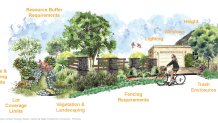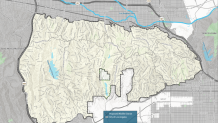
What to Know
- LA's proposed Wildlife District ordinance took another step forward after a vote by the city council.
- The proposed ordinance would regulate development standards for lot sizes; set grading and height limitations; set standards for fences and trash enclosures; and establish window and lighting requirements.
- The goal of these rules is to preserve natural habitats and ensure there are enough wildlife corridors for animals such as bobcats and mountain lions to pass through.
Hoping to protect the animals that call Los Angeles home, officials approved the proposal of a development ordinance meant to protect wildlife in key areas of the city despite controversy and pushback from some residents.
The proposed Wildlife District Ordinance, designed to minimize the impact of hillside homes on the surrounding environment, was unanimously backed by an LA City Council committee on Tuesday and will now head to the full council for a vote.
The City Council Planning and Land Use Management (PLUM) Committee approved the plan, which would impose building and development regulations in order to balance wildlife habitats and private property development around the Santa Monica Mountains and Griffith Park.
Get Southern California news, weather forecasts and entertainment stories to your inbox. Sign up for NBC LA newsletters.
“Over the last few decades we’ve seen development in the hillside scale out of proportion, resulting in unsafe conditions not only for wildlife, but also for people,” said Councilmember Katy Yaroslavsky, who sits on the committee.
“The wildlife is already here. It’s our responsibility to care for it to allow it space to flourish and to recognize the positive intangible benefits.”

The proposed ordinance would regulate development standards for lot sizes; set grading and height limitations; set standards for fences and trash enclosures; and establish window and lighting requirements. The goal of these rules is to preserve natural habitats and ensure there are enough wildlife corridors for animals such as bobcats and mountain lions to pass through.
Local
Get Los Angeles's latest local news on crime, entertainment, weather, schools, COVID, cost of living and more. Here's your go-to source for today's LA news.
The regulations would apply only to new developments and major remodels of existing homes and property. It would not require homeowners to alter their existing properties or apply the new rules to minor renovations, according to the drafted ordinance.
The plan would first be piloted in an area between Griffith Park and the 405 Freeway, including hillside communities in Sherman Oaks, Hollywood Hills, Bel Air, Laurel Canyon, and Beverly Crest.
Eventually, the city would look to expand to include similar "protection areas" for wildlife citywide.

Planning department staff began working on the Wildlife District Ordinance in 2014. Since then, officials have engaged in public outreach to bring awareness to the proposed plan, including workshops between 2018-2021, public hearings in 2022, and mailed notices to the more than 60,000 residents living in the affected area.
City officials consulted various research teams of ecologists and biologists in order to study the ecological impacts of property development and to inform the ordinance’s regulations.
Supporters and opponents of the plan bumped heads for over an hour Tuesday as residents and community members delivered public comments at a packed City Hall. Supporters claimed that development in the forested areas of the Santa Monica Mountains has long been unsustainable, affecting wildlife and increasing wildfire risks.
“When it comes to environmental issues, we’re often playing catch-up and taking action after damage has been done, such as having to build an expensive bridge for wildlife to cross because we didn’t plan our freeways with animals in mind. With this ordinance we’re doing something proactive,” said Andrew Laskin, a Sherman Oaks resident living within the proposed pilot area.
However, opponents said the proposed rules would violate property rights and diminish property values in the area.
“The idea that we have to choose between protecting our planet and protecting homeowners is a false narrative. We can do this without pillaging people’s life savings,” said Jon Grauman, a local real estate agent.
Los Angeles -- which is located in a global biodiversity hotspot -- is seeing an increase in developments in ecologically significant areas, according to the city's planning department. The average size of homes in the plan’s proposed wildlife district has more than doubled in the last six decades -- from 4,300 square feet in 1962 to 8,800 square feet in 2020.



